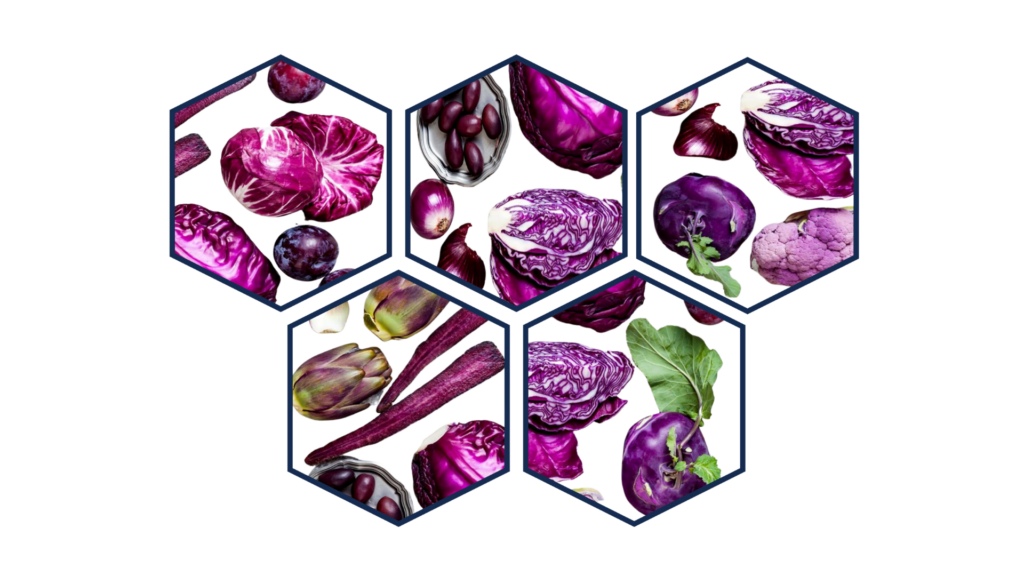Happy Thanksgiving 2023
Anthocyanins and the pancreas
Anthocyanins are a class of water-soluble flavonoids widely present in fruits and vegetables. They are the pigments that give purple fruits and veggies their rich color. Anthocyanins have been linked to anti-inflammatory, anti-viral, and anti-cancer benefits. Fruits, vegetables and grains with red, purple, blue or black hues tend to be rich in anthocyanins. Berries have the highest levels, particularly black elderberries and aronia berries (chokeberries). Red cabbage, red onions, red radishes, purple cauliflower, purple corn and the skin of purple eggplant, black beans, black rice and black soybeans – even grape juice and wine – contain anthocyanins.
Studies suggest that anthocyanins might even even inhibit the growth of cancer.1
These studies demonstrate the important role of anthocyanin-based foods in lowering inflammation, oxidative stress, and polyps or tumors in parts of the gastrointestinal system. The foods that have demonstrated positive results are black raspberries, bilberries, and strawberries, associated with a decrease of oxidative stress and markers of inflammation. 2
Anthocyanins’ antioxidant and anti-inflammatory properties also counter chronic inflammation and the potential prevention of gastrointestinal cancers, including pancreatic cancer.3
Pancreatitis is inflammation of the pancreas. Inflammation in the pancreas can be caused by heavy alcohol use, high triglyceride levels in the blood, and high calcium levels in the blood. Pancreatitis can be an acute condition, appearing suddenly and generally lasting a short time. But repeated episodes can lead to chronic pancreatitis, which is a long-term condition. The damage to the pancreas can get worse over time, eventually leading to pancreatic cancer.
Unfortunately, the holiday season encourages us to “eat (fatty foods), drink (alcohol), and be merry”. Leading to some heavy (not so merry) consequences for our pancreases.
This Thanksgiving, consider incorporating some of these anthocyanin rich recipes to your dinner spread. Provide cholesterol-lowering options (including limiting/avoiding fatty, high cholesterol foods). Your family (and your pancreas) will thank you!

1. Wang LS, Stoner GD. Anthocyanins and their role in cancer prevention. Cancer Lett. 2008 Oct 8;269(2):281-90. doi: 10.1016/j.canlet.2008.05.020. Epub 2008 Jun 20. PMID: 18571839; PMCID: PMC2582525.
2. Kuntz S, Kunz C, Rudloff S. Inhibition of pancreatic cancer cell migration by plasma anthocyanins isolated from healthy volunteers receiving an anthocyanin-rich berry juice. Eur J Nutr. 2017 Feb;56(1):203-214. doi: 10.1007/s00394-015-1070-3. Epub 2015 Oct 17. PMID: 26476633.
3. Elvira Gonzalez de Mejia, Miguel Rebollo-Hernanz, Yolanda Aguilera, Maria A. Martín-Cabrejas,
Chapter 24 – Role of anthocyanins in oxidative stress and the prevention of cancer in the digestive system,
Editor(s): Victor R. Preedy, Vinood B. Patel, Cancer (Second Edition), Academic Press, 2021, Pages 265-280, ISBN 9780128195475, https://doi.org/10.1016/B978-0-12-819547-5.00024-9.
(https://www.sciencedirect.com/science/article/pii/B9780128195475000249)
4. Ma Z, Du B, Li J, Yang Y, Zhu F. An Insight into Anti-Inflammatory Activities and Inflammation Related Diseases of Anthocyanins: A Review of Both In Vivo and In Vitro Investigations. Int J Mol Sci. 2021 Oct 14;22(20):11076. doi: 10.3390/ijms222011076. PMID: 34681733; PMCID: PMC8540239.

